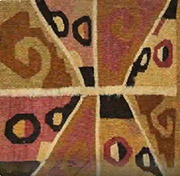Center, Textile Research

IX Jornadas Internacionales de Textiles Precolombinos y Amerindianos / 9th International Conference on PreColumbian and Amerindian Textiles, Museo delle Culture, Milan, 2022
Date of this Version
2024
Document Type
Article
Citation
Published in IX Jornadas Internacionales de Textiles Precolombinos y Amerindianos / 9th International Conference on Pre-Columbian and Amerindian Textiles, Museo delle Culture, Milan, 2022. (Lincoln, Nebraska: Zea Books, 2024)
DOI: 10.32873/unl.dc.zea.1619
Abstract
Una revisión de distintas evidencias materiales provenientes principalmente de contextos funerarios de personajes de la élite gobernante mochica, así como de las imágenes plasmadas en la cerámica, metales y arte mural policromo, dejan entrever aspectos poco conocidos sobre el rol que cumplió la textilería en esta sociedad (100 – 850 d. C.), revelando una serie de temas simbólicos vinculados a los mitos y ritos que formaron parte de la cosmovisión andina mochica que, además, se fundieron con la propuesta ideológica impuesta por la clase gobernante. Las evidencias y contextos registrados durante las excavaciones arqueológicas permiten sostener que, en los distintos rituales celebrados por los mochica, los textiles y demás componentes de su entorno de producción fueron considerados como elementos interactivos, empleados para propiciar el bienestar, la protección y la reproducción de la comunidad, a través del culto a la fertilidad, el culto a los ancestros y otras ceremonias mágico-religiosas. De otro lado, la indumentaria, ya sea de simple o compleja elaboración, dio origen a un lenguaje visual que permitió establecer marcadas diferencias sociales, así como identificar roles y/o funciones específicas en la ejecución de los rituales.
A review of different material evidence, mainly coming from funerary contexts of characters from the ruling elite, as well as images embodied in ceramics, metals, and polychrome mural art, reveal little-known aspects about the role that textiles played in Mochica society. Symbolic themes linked to the myths and rites that are part of the Andean Mochica worldview, which merge with the ideological proposal imposed by the ruling class. The evidence and contexts recorded during the archaeological excavations allow us to argue that in the different rituals celebrated by the Mochica, textiles and everything that was part of their production environment were considered interactive elements, used to promote the well-being, protection, and reproduction of the community, through fertility cult rituals, ancestor worship and magical-religious themes. On the other hand, clothing, whether simple or complex, gave rise to a visual language that made it possible to establish marked social differences, identify specific roles and/or functions in the execution of rituals.
Included in
American Material Culture Commons, Art and Materials Conservation Commons, Fiber, Textile, and Weaving Arts Commons, Indigenous Studies Commons, Latin American History Commons, Museum Studies Commons, Native American Studies Commons, Other History of Art, Architecture, and Archaeology Commons, Other Religion Commons


Comments
Copyright © 2024 Arabel Fernández López